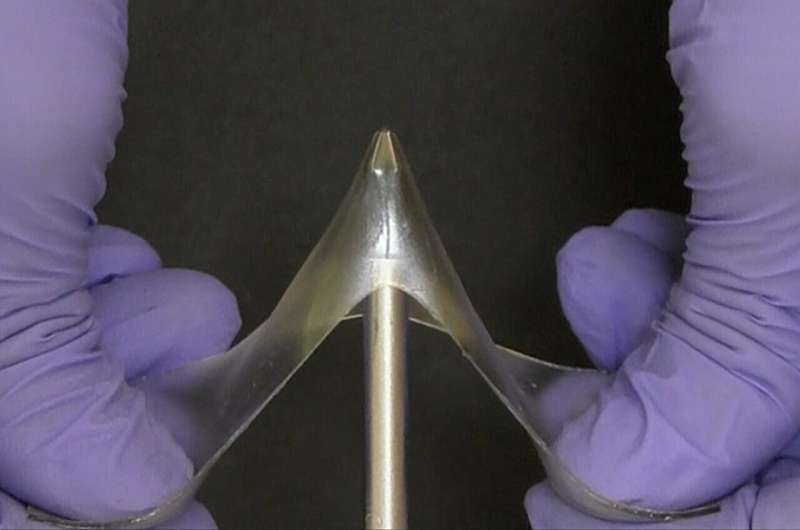This article has been reviewed according to Science X's editorial process and policies. Editors have highlighted the following attributes while ensuring the content's credibility:
fact-checked
peer-reviewed publication
trusted source
proofread
Researchers create new class of materials called 'glassy gels'

Researchers have created a new class of materials called "glassy gels" that are very hard and difficult to break despite containing more than 50% liquid. Coupled with the fact that glassy gels are simple to produce, the material holds promise for a variety of applications.
A paper describing this work, titled "Glassy Gels Toughened by Solvent," appears in the journal Nature.
Gels and glassy polymers are classes of materials that have historically been viewed as distinct from one another. Glassy polymers are hard, stiff and often brittle. They're used to make things like water bottles or airplane windows. Gels—such as contact lenses—contain liquid and are soft and stretchy.
"We've created a class of materials that we've termed glassy gels, which are as hard as glassy polymers, but—if you apply enough force—can stretch up to five times their original length, rather than breaking," says Michael Dickey, corresponding author of a paper on the work and the Camille and Henry Dreyfus Professor of Chemical and Biomolecular Engineering at North Carolina State University. "What's more, once the material has been stretched, you can get it to return to its original shape by applying heat. In addition, the surface of the glassy gels is highly adhesive, which is unusual for hard materials."
"A key thing that distinguishes glassy gels is that they are more than 50% liquid, which makes them more efficient conductors of electricity than common plastics that have comparable physical characteristics," says Meixiang Wang, co-lead author of the paper and a postdoctoral researcher at NC State. "Considering the number of unique properties they possess, we're optimistic that these materials will be useful."
Glassy gels, as the name suggests, are effectively a material that combines some of the most attractive properties of both glassy polymers and gels. To make them, the researchers start with the liquid precursors of glassy polymers and mix them with an ionic liquid. This combined liquid is poured into a mold and exposed to ultraviolet light, which "cures" the material. The mold is then removed, leaving behind the glassy gel.
"The ionic liquid is a solvent, like water, but is made entirely of ions," says Dickey. "Normally, when you add a solvent to a polymer, the solvent pushes apart the polymer chains, making the polymer soft and stretchable. That's why a wet contact lens is pliable, and a dry contact lens isn't. In glassy gels, the solvent pushes the molecular chains in the polymer apart, which allows it to be stretchable like a gel.
"However, the ions in the solvent are strongly attracted to the polymer, which prevents the polymer chains from moving. The inability of chains to move is what makes it glassy. The end result is that the material is hard due to the attractive forces, but is still capable of stretching due to the extra spacing."
The researchers found that glassy gels could be made with a variety of different polymers and ionic liquids, though not all classes of polymers can be used to create glassy gels.
"Polymers that are charged or polar hold promise for glassy gels, because they're attracted to the ionic liquid," Dickey says.
In testing, the researchers found that the glassy gels don't evaporate or dry out, even though they consist of 50–60% liquid.
"Maybe the most intriguing characteristic of the glassy gels is how adhesive they are," says Dickey. "Because while we understand what makes them hard and stretchable, we can only speculate about what makes them so sticky."
The researchers also think glassy gels hold promise for practical applications because they're easy to make.
"Creating glassy gels is a simple process that can be done by curing it in any type of mold or by 3D printing it," says Dickey. "Most plastics with similar mechanical properties require manufacturers to create polymer as a feedstock and then transport that polymer to another facility where the polymer is melted and formed into the end product.
"We're excited to see how glassy gels can be used and are open to working with collaborators on identifying applications for these materials."
Co-lead author of the paper is Xun Xiao of the University of North Carolina at Chapel Hill. The paper was co-authored by Salma Siddika, a Ph.D. student at NC State; Mohammad Shamsi, a former Ph.D. student at NC State; Ethan Frey, a former undergrad at NC state; Brendan O'Connor, a professor of mechanical and aerospace engineering at NC State; Wubin Bai, a professor of applied physical sciences at UNC; and Wen Qian, a research associate professor of mechanical and materials engineering at the University of Nebraska-Lincoln.
More information: Michael Dickey, Glassy gels toughened by solvent, Nature (2024). DOI: 10.1038/s41586-024-07564-0. www.nature.com/articles/s41586-024-07564-0
Journal information: Nature
Provided by North Carolina State University





















